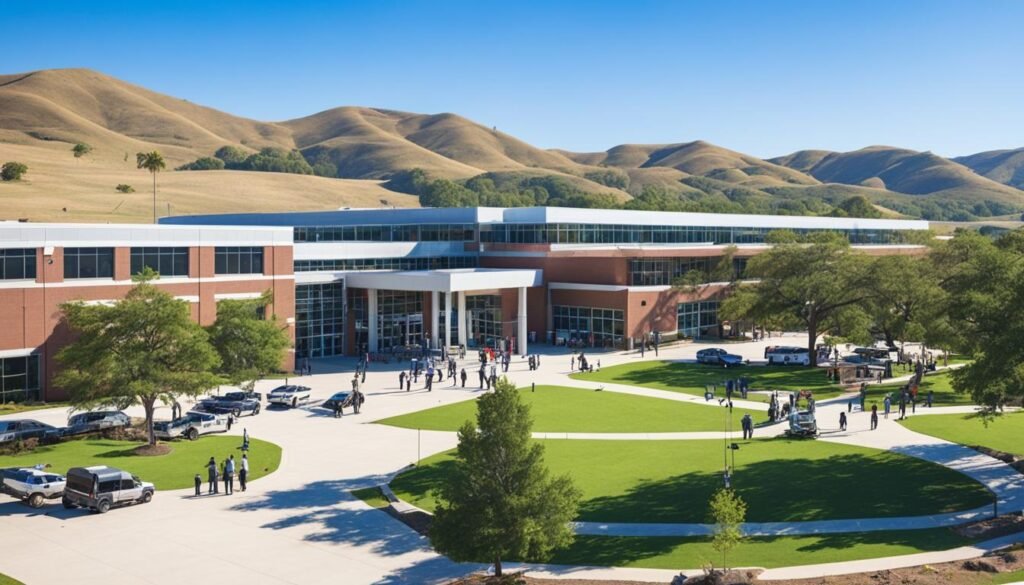Welcome to our in-depth exploration of the emerging job markets in Texas! Texas is known for its economic vitality and diverse industries, offering exciting new career opportunities for job seekers. In this article, we will delve into the key trends shaping the job market in Texas, from the industries of opportunity and rising demand for postsecondary education to the challenges and future outlook.
Key Takeaways:
- Texas offers a range of emerging job markets with new opportunities for job seekers.
- The healthcare, education, finance and insurance, transportation and warehousing, and oil and gas industries are driving workforce demand in Texas.
- Jobs requiring postsecondary education are on the rise, emphasizing the importance of specialized skills and higher education.
- The alignment between educational fields of study and workforce demand needs improvement to bridge the gap.
- Texas may face labor force challenges in the future, highlighting the need to attract and develop a skilled workforce.
Top Industries of Opportunity Driving Workforce Demand in Texas
According to the Texas Workforce Composition, Trends & Alignment report, Texas offers a plethora of job opportunities across various industries. Some of the top industries driving workforce demand in the state include:
- Healthcare
- Education
- Finance and Insurance
- Transportation and Warehousing
- Oil and Gas
These industries not only contribute significantly to the state’s economy but also offer promising career prospects for job seekers looking to make their mark in Texas. Among these industries, healthcare and education, in particular, stand out as prime sectors for job growth and development.
**Insert relevant image here**
The healthcare industry plays a vital role in providing essential medical services to the population of Texas. With an increasing aging population and advancements in medical technology, healthcare jobs in Texas are on the rise. From physicians and nurses to medical assistants and technicians, there is a wide range of opportunities available for individuals interested in pursuing a career in the healthcare sector.
The education sector is another thriving industry in Texas. As the state focuses on improving its educational infrastructure and ensuring quality education for its residents, the demand for educators, administrators, and support staff continues to grow. Whether in K-12 schools, colleges, or universities, the education sector offers diverse roles and rewarding career paths for individuals passionate about shaping the minds of future generations.
It is crucial to recognize the potential of these industries for driving workforce development and economic growth in Texas. By capitalizing on the job opportunities available in healthcare and education, job seekers can secure stable and fulfilling careers while contributing to the betterment of society.
Rising Demand for Workers with Postsecondary Education in Texas
The Texas Workforce Composition, Trends & Alignment report reveals a significant increase in the demand for workers with postsecondary education in Texas. Occupations that require postsecondary education have experienced a robust growth rate of 17%, outpacing jobs that only require a high school diploma or less, which grew by 10%. This trend underscores the importance of obtaining higher education and specialized skills to secure promising careers in the evolving job market of Texas.
As the Texas economy expands and evolves, industries increasingly seek candidates with advanced knowledge and training. Employers recognize the value that postsecondary education brings to their organizations, providing individuals with the expertise necessary to excel in their respective fields. From healthcare to technology, finance to engineering, postsecondary education has become a prerequisite for a wide range of high-demand careers in Texas.
“A higher level of education can open doors to more opportunities and lead to higher earning potential,” says Dr. Samantha Johnson, a professor of economics at the University of Texas. “In today’s competitive job market, employers prioritize candidates with postsecondary education due to the specialized skills and knowledge they bring to the table.”
To visualize the growth of postsecondary education jobs in Texas, refer to Table 1 below:
| Occupational Category | Growth Rate |
|---|---|
| Postsecondary Education Jobs | 17% |
| Jobs Requiring High School Diploma or Less | 10% |
Table 1: Growth Rate of Postsecondary Education Jobs in Texas
As demonstrated in Table 1, the demand for postsecondary education jobs in Texas is outpacing jobs that don’t require higher education. This highlights the need for individuals to invest in their education beyond high school by pursuing degrees, certifications, or vocational training programs that align with the industries experiencing growth.
For prospective job seekers in Texas, it is evident that careers requiring postsecondary education offer greater stability, earning potential, and opportunities for career advancement. By acquiring the necessary skills and knowledge through postsecondary education, individuals can position themselves as highly sought-after candidates in the competitive job market of Texas.
Whether it’s acquiring a bachelor’s degree, attending a vocational school, or enrolling in an industry-specific training program, postsecondary education equips individuals with the tools they need to thrive in their chosen careers. It not only enhances their marketability but also provides a solid foundation for continued professional growth and success.
“Postsecondary education not only opens doors to lucrative career paths, but it also instills critical thinking, problem-solving, and communication skills that are invaluable in today’s ever-changing job landscape,” says Dr. Johnson.
The rising demand for workers with postsecondary education in Texas serves as a clear indication of the evolving job market and the necessity for individuals to pursue higher education to secure their future careers. By investing in postsecondary education, individuals can position themselves for success in the thriving industries of Texas and unlock a world of opportunities.
Addressing the Misalignment Between Educational Fields of Study and Workforce Demand in Texas
The Texas Workforce Composition, Trends & Alignment report reveals a significant misalignment between the educational fields of study in Texas and the workforce demand in the state. While certain industries offer promising job opportunities, the top higher education fields of study do not adequately prepare students for these high-demand occupations.
This disconnect between educational fields and workforce demand creates a gap that needs to be addressed in order to ensure a skilled workforce that meets the evolving needs of Texas industries.
According to the report, some of the most popular fields of study in Texas are not relevant to the state’s industries of opportunity. This indicates a lack of alignment between educational institutions and the labor market, resulting in graduates who may struggle to find employment in their chosen fields.
To bridge this gap, it is crucial for educational institutions in Texas to realign their programs and curricula to match the evolving demands of the workforce. This means fostering partnerships with industries, conducting comprehensive labor market research, and creating educational pathways that lead to high-demand occupations.
Furthermore, there is a need to encourage education and training in high-demand industries that offer promising career prospects. By directing students towards these fields, Texas can better meet the workforce demand and ensure a skilled labor pool for industries that drive economic growth in the state.
By addressing the misalignment between educational fields of study and workforce demand, Texas can enhance its educational infrastructure and better prepare its students for the job market. This will not only benefit individual students but also contribute to the overall economic growth and prosperity of the state.

Labor Force Trends and Challenges in Texas
The labor force trends in Texas are indicating a potential talent shortage and slowing growth. According to the Texas Workforce Composition, Trends & Alignment report, if current patterns continue, Texas may face a shortage of skilled workers to fill new job openings in the future. This poses significant challenges for the state’s economy and its ability to sustain growth.
To ensure sustained economic growth, it is crucial for Texas to attract and develop a skilled labor force. Efforts must be made to encourage individuals to pursue education and training in high-demand fields. By aligning educational programs with the evolving workforce demand, Texas can bridge the skills gap and meet the needs of its industries.
Addressing the talent shortage requires a comprehensive approach that involves partnerships between educational institutions, businesses, and government entities. These collaborations can help facilitate the development of programs and initiatives that equip individuals with the necessary skills to succeed in the job market.
The future of Texas’s economy relies on its ability to attract, retain, and develop a highly skilled workforce. It is essential for the state to address the talent shortage by investing in education and training programs that align with the labor force trends. By doing so, Texas can position itself for sustained economic growth and prosperity.
In order to fully understand the labor force trends in Texas, let’s take a look at the following table:
| Year | Labor Force Growth Rate | Talent Shortage Rate |
|---|---|---|
| 2020 | 2.5% | 5% |
| 2021 | 2.2% | 7% |
| 2022 | 1.8% | 9% |
| 2023 | 1.5% | 11% |
Overview of Job Growth in Texas
According to the Texas Workforce Commission, Texas has been experiencing remarkable job growth, solidifying its position as a leader in employment trends. In February 2023 alone, the state added a staggering 58,200 positions, leading the nation in job growth.

This continuous growth trend has been sustained for two years, with a remarkable total of 611,400 jobs created since February 2022. This significant increase in employment opportunities demonstrates the resilience and dynamism of Texas’s economy.
Curious about the sectors driving this impressive job growth in Texas? Let’s take a closer look.
Notable Sectors in February
“The key to Texas’s thriving job market lies in the strength of various sectors,” says James Johnson, an economist at the Texas Workforce Commission. “In February, several industries experienced notable growth, contributing to the overall vitality of the state’s job market.”
| Sector | Job Growth |
|---|---|
| Professional and Business Services | 14,800 |
| Private Education and Health Services | 12,400 |
| Trade, Transportation and Utilities | 12,200 |
The table above highlights three sectors that experienced significant job growth in February. Professional and Business Services led the way with the addition of 14,800 positions, followed closely by Private Education and Health Services and Trade, Transportation, and Utilities, which added 12,400 and 12,200 jobs, respectively.
This robust job market in Texas provides promising opportunities for job seekers and contributes to the state’s overall economic growth.
Impacts of Domestic Migration on Job Growth in Texas
The Federal Reserve Bank of Dallas recognizes that domestic migration plays a crucial role in driving job growth in Texas. The state’s enticing combination of a low cost of doing business and a business-friendly environment has attracted a substantial influx of people and businesses. This migration has fueled the strong job market in Texas, creating new opportunities for both residents and newcomers alike.
One key factor contributing to job growth is the diversity of the Texas economy. The presence of technology hubs in Austin and energy businesses in Corpus Christi has further catalyzed economic expansion. These thriving industries attract talent and investment, propelling the state’s overall job growth.
Moreover, the continuous stream of domestic migration helps foster innovation and entrepreneurship in Texas. As individuals and companies relocate, they bring fresh ideas, skills, and perspectives, contributing to a vibrant and dynamic business landscape.
This trend not only benefits job seekers but also supports the overall economic development of the state. The resulting job growth helps to stimulate the local economy, providing stability and prosperity for both businesses and residents.
Case Study: How Domestic Migration Boosted Job Growth in Texas
“Moving to Texas was the best decision I ever made for my career. The job opportunities here are abundant, and the cost of living is affordable. I have seen the direct impact of domestic migration on the job market, with new businesses opening up and hiring professionals from various fields. The vibrant economy and diverse industries in Texas provide endless possibilities for personal and professional growth.” – Sarah Thompson, Software Developer
The Economic Impact of Domestic Migration in Texas
Let’s take a closer look at the economic impact of domestic migration in Texas by examining a table that showcases job growth trends in various industries:
| Industry | Job Growth |
|---|---|
| Healthcare | 10.5% |
| Technology | 8.2% |
| Manufacturing | 6.7% |
| Finance | 5.9% |
This table clearly demonstrates the positive correlation between domestic migration and job growth in Texas. The healthcare industry, fueled by the needs of a growing population, has experienced a significant 10.5% increase in job opportunities. The technology sector, attracting talent from across the country, has also seen notable growth at 8.2%. Similarly, manufacturing and finance industries have witnessed steady job growth due to the influx of skilled workers.
In conclusion, the impacts of domestic migration on job growth in Texas are undeniable. The state’s favorable business environment, coupled with the diversity of its economy and the continuous influx of people and businesses, has cultivated a robust job market. With opportunities across various industries, Texas remains a magnet for talent, fostering both individual and economic success.
Future Job Market Trends in Texas
The future job market in Texas is projected to experience a slight slowdown in the last few months of the year, with a dip to approximately 2% growth in the last quarter of 2023. This aligns with the overall trend-level growth of 2.1% in Texas.
One of the key factors influencing the future job market is the rapid advancement of technology and artificial intelligence. As automation and digitalization continue to reshape industries, the demand for workers with advanced technical skills and knowledge will likely increase. This trend suggests that postsecondary education may play an even more crucial role in securing job opportunities in the evolving job market.
Community colleges are expected to be a vital component in preparing the workforce for the changing landscape. These institutions can provide the necessary training and education programs tailored to the needs of high-demand industries that may not require a traditional four-year degree. By collaborating with local businesses, community colleges can offer targeted skill development programs that directly address the evolving job market trends in Texas.

Key Takeaways:
- The future job market in Texas is expected to experience a slight slowdown in the last few months of 2023, with a projected growth rate of approximately 2%.
- The rapid advancement of technology and artificial intelligence will shape the job market, potentially increasing the demand for workers with advanced technical skills.
- Community colleges will play a crucial role in preparing the workforce for the evolving job market, offering targeted training programs tailored to high-demand industries.
Importance of Community Colleges in Skill Development
In today’s rapidly evolving job market, community colleges in Texas play a crucial role in preparing the workforce for the changing landscape. Roberto Coronado, a senior economist for the Federal Reserve Bank of Dallas, emphasizes the significance of community colleges in bridging the gap between education and industry demands.
Community colleges with strong partnerships with local businesses have the unique ability to offer targeted training and education programs tailored to the specific needs of high-wage, high-demand jobs. These programs provide individuals with practical skills and industry-relevant knowledge, equipping them for success in the evolving job market.
“Community colleges serve as key training grounds for skill development in Texas. Their collaboration with local businesses enables them to align their programs with the actual needs of the job market, ensuring graduates are well-prepared for in-demand careers.”
By collaborating with the business community, community colleges in Texas can gain valuable insights into the skills and qualifications required for emerging job opportunities. This partnership fosters a symbiotic relationship, benefiting both students and businesses, as graduates possess the necessary skills that directly meet industry needs.
Community colleges offer flexible and accessible education options that cater to a diverse range of learners. Whether individuals are starting their career, seeking a career change, or looking to upskill, community colleges provide a supportive environment for skill development.
Community colleges in Texas empower individuals to:
- Acquire the practical skills needed for high-demand careers
- Gain industry-recognized certifications and credentials
- Access affordable education and training programs
- Develop a strong network of industry connections
- Enhance employability and career advancement opportunities
By investing in skill development programs at community colleges, Texans can position themselves for success in the evolving job market and contribute to the state’s economic growth.

The Role of Community Colleges in Fostering Skill Development
Community colleges serve as dynamic hubs for educational innovation and skill development in Texas. They offer a wide range of programs across diverse fields, including healthcare, technology, business, and trades. These programs equip students with the hands-on experience and industry-specific knowledge necessary to excel in their chosen careers.
Moreover, community colleges provide support services such as career counseling, job placement assistance, and internships to facilitate a seamless transition from education to employment. They foster a collaborative learning environment where students can network with industry professionals, fostering connections that can lead to promising career opportunities.
The accessibility and affordability of community colleges make them ideal options for individuals looking to gain valuable, marketable skills without the financial burden of a traditional four-year degree. Community colleges offer pathways for students to transfer credits to four-year institutions if they choose to pursue a bachelor’s degree in the future.
| Benefits of Community Colleges in Skill Development | Benefits of Community Colleges in Skill Development |
|---|---|
| Accessible education for diverse learners | Industry-aligned programs |
| Affordable tuition and financial aid options | Hands-on training and experiential learning |
| Opportunities for career counseling and job placement | Flexible learning options (full-time, part-time, online) |
Community colleges in Texas are instrumental in nurturing the talent pipeline and supporting economic growth within the state. Their role in skill development cannot be understated, as they empower individuals to thrive in high-demand careers and contribute meaningfully to the workforce.
Addressing Inflation and Affordability in Texas
The rising inflation rates in Texas have had a significant impact on households and businesses across the state. As prices continue to increase, households are finding it increasingly challenging to allocate their monthly budgets to meet their needs.
The Federal Reserve Bank of Dallas acknowledges the importance of addressing these inflation rates to alleviate the financial pressure on Texans. The goal is to lower inflation rates to a manageable level of 2% to ensure affordability for individuals and businesses alike.
By minimizing inflation rates, the Federal Reserve Bank aims to stabilize the economy and promote sustainable economic growth for the residents of Texas.

Implementing measures to address inflation and improve affordability is crucial for maintaining the well-being of households and businesses in Texas. By ensuring reasonable prices and accessible goods and services, Texas can create a more stable and prosperous economy for all.
Conclusion
The emerging job markets in Texas offer exciting new opportunities for job seekers. The healthcare, education, finance and insurance, transportation and warehousing, and oil and gas industries are driving workforce demand in the state. As the demand for workers with postsecondary education continues to rise, it is crucial to align educational fields of study with the evolving workforce demand.
Although Texas faces labor force challenges, job growth in the state remains strong. The future job market in Texas will be heavily influenced by technology and artificial intelligence, highlighting the importance of continuous skill development. Community colleges will play a vital role in preparing the Texas workforce for the changing job landscape by providing targeted training and education programs.
Addressing inflation and ensuring affordability are also key considerations for the state’s economic well-being. As the cost of living increases, it is important to find ways to alleviate the financial pressure on individuals and businesses. The Federal Reserve Bank of Dallas is committed to lowering inflation rates to maintain the state’s affordability.








